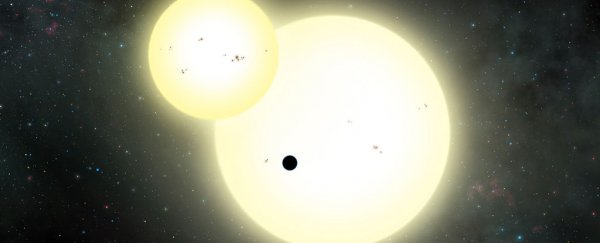Located about 3,700 light-years away, in the direction of the Cygnus constellation, lies a distant planet called Kepler–1647b, which at approximately 4.4 billion years of age is roughly as old as Earth.
But that's about where the similarities end, because Kepler–1647b turns out to hold a pretty sensational point of difference: this newly identified world is the largest planet ever discovered that orbits two stars. Known as circumbinary planets, these strange cosmic phenomena are often called 'Tatooine' planets, after Luke Skywalker's dusty desert home.
An international team of astronomers led by NASA's Goddard Space Flight Centre just announced the discovery of Kepler–1647b, which has a mass and radius that are nearly identical to Jupiter's. But just because this circumbinary planet might be the largest of its kind that we currently know about, that didn't make locating it any easier.
"[F]inding circumbinary planets is much harder than finding planets around single stars," said astronomer William Welsh from San Diego State University (SDSU). "The transits are not regularly spaced in time and they can vary in duration and even depth."
The team identified the planet using data recorded by the Kepler space observatory, and adding to the challenge was Kepler–1647b's other remarkable feature – the immense length of its orbital period. At 1,107 days, this is the longest of any confirmed transiting exoplanet astronomers have yet found.
 Artist's impression. Credit: Lynette Cook
Artist's impression. Credit: Lynette Cook
This means it takes over three years for Kepler–1647b to orbit its host stars - both of which are similar in size to our Sun, with one being slightly smaller, and the other being slightly larger.
That epic orbital period is the result of Kepler–1647b being located further away from its host stars than other circumbinary planets, which usually hold relatively tight orbits. In the image below, you can see just how much wider Kepler–1647b's orbit (in red) is compared to its circumbinary counterparts (in grey), with Earth's orbit (in blue) added in for reference.
"It's a bit curious that this biggest planet took so long to confirm, since it is easier to find big planets than small ones," said SDSU astronomer Jerome Orosz. "But it is because its orbital period is so long."
 Comparison of the relative sizes of several Kepler circumbinary planets. Credit: Lynette Cook
Comparison of the relative sizes of several Kepler circumbinary planets. Credit: Lynette Cook
Evidence for Kepler–1647b's existence was first found back in 2011, when one of the team, Laurance Doyle from the SETI Institute, spotted the planet transit in front of one of its stars. But it took several extra years of analysis and observations – supported by amateur astronomers using the Kilodegree Extremely Little Telescopes in the US and South Africa – before the researchers confirmed that Kepler–1647b was a circumbinary planet.
While Kepler–1647b's distance from its stars is greater than usual for a circumbinary planet, it's actually within the habitable zone – the distance from a star at which liquid water could exist on a planet's surface, not being so far away that it would freeze, nor so close that it would evaporate.
But, in this case, since Kepler–1647b is a gas giant like Jupiter, the researchers think it's unlikely to host life – although there's a possibility any as-yet-undiscovered moons orbiting the planet could provide a suitable environment for it. Sadly, this means there's probably nobody looking up to see a beautiful two-star sunset like the one Luke Skywalker watches in Star Wars.
 Comparison of the orbits of the Kepler circumbinary planets. Kepler–1647 b's orbit is shown in red. Other planets are shown in grey. For comparison, the Earth's orbit is shown in blue. Credits: B. Quarles
Comparison of the orbits of the Kepler circumbinary planets. Kepler–1647 b's orbit is shown in red. Other planets are shown in grey. For comparison, the Earth's orbit is shown in blue. Credits: B. Quarles
But just because we probably won't find alien life on Kepler–1647b doesn't mean the planet isn't a major find. In addition to its record-breaking size and orbital length, the scientists think this Tatooine-esque planet could herald the discovery of a new generation of similar worlds that have eluded us until now.
When you consider that the first such planet – Kepler–16b – was only discovered five years ago, it becomes clear why this is such an exciting time for astronomy. Kepler–1647b is the 11th confirmed circumbinary planet discovered by the Kepler telescope since then.
"Habitability aside, Kepler–1647b is important because it is the tip of the iceberg of a theoretically predicted population of large, long-period circumbinary planets," said Welsh.
The findings have been accepted for publication in The Astrophysical Journal.
